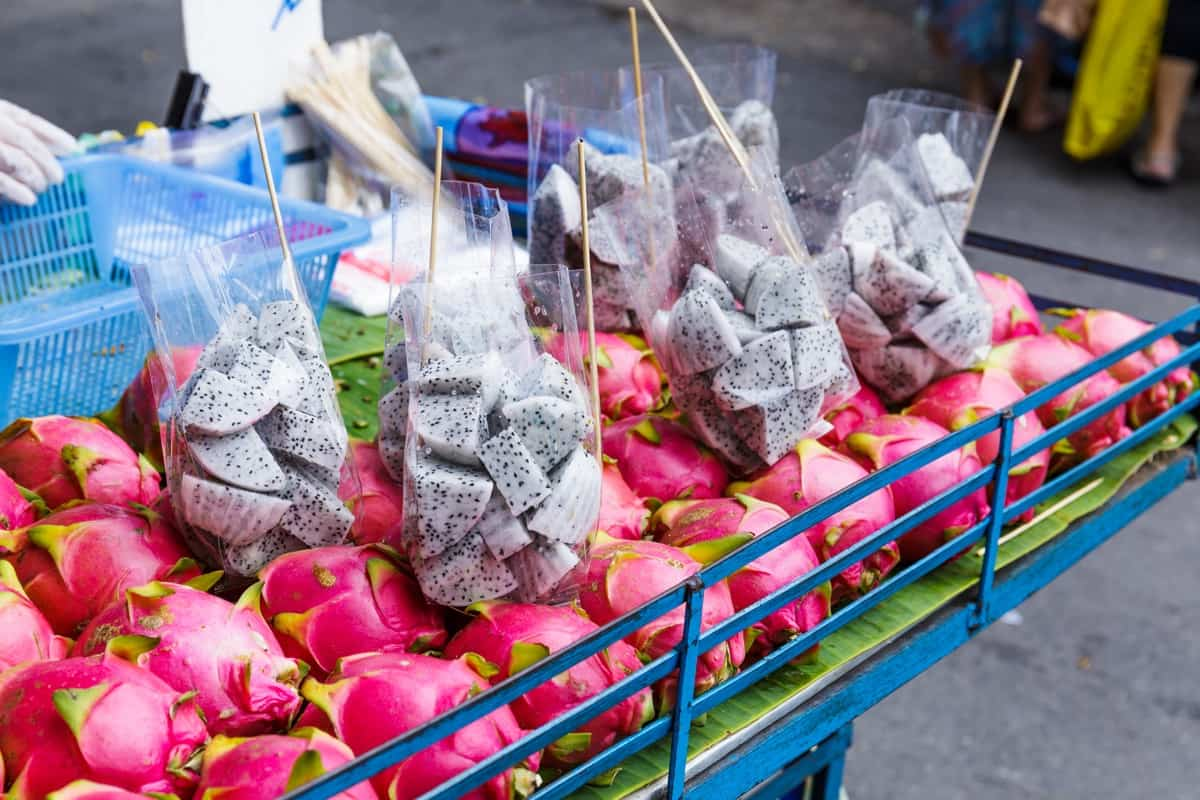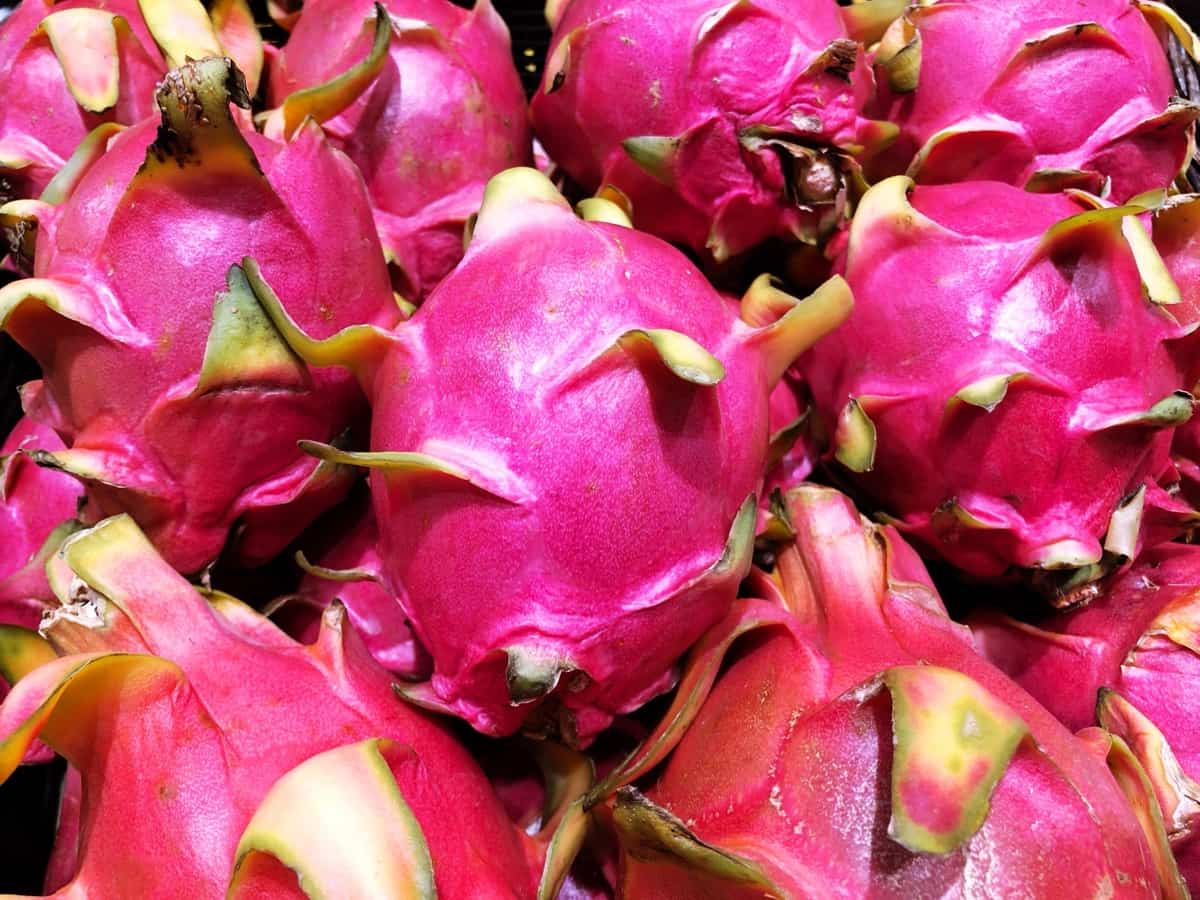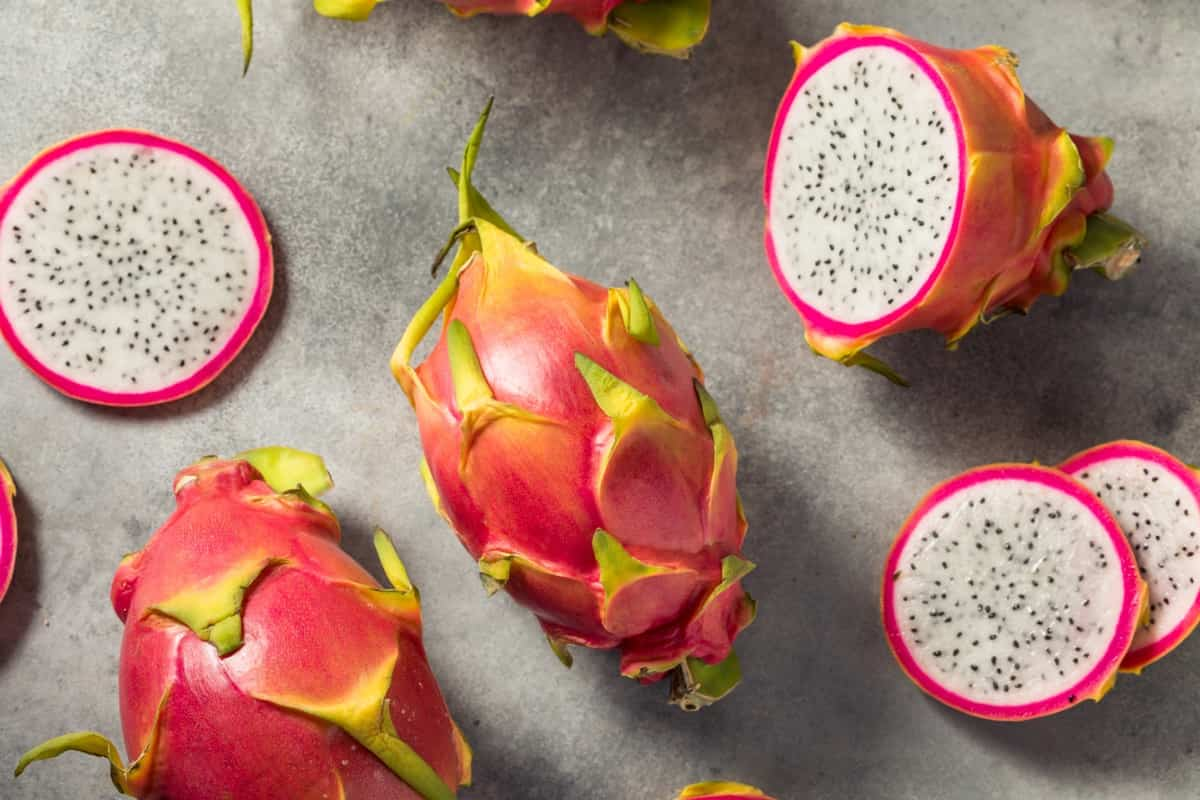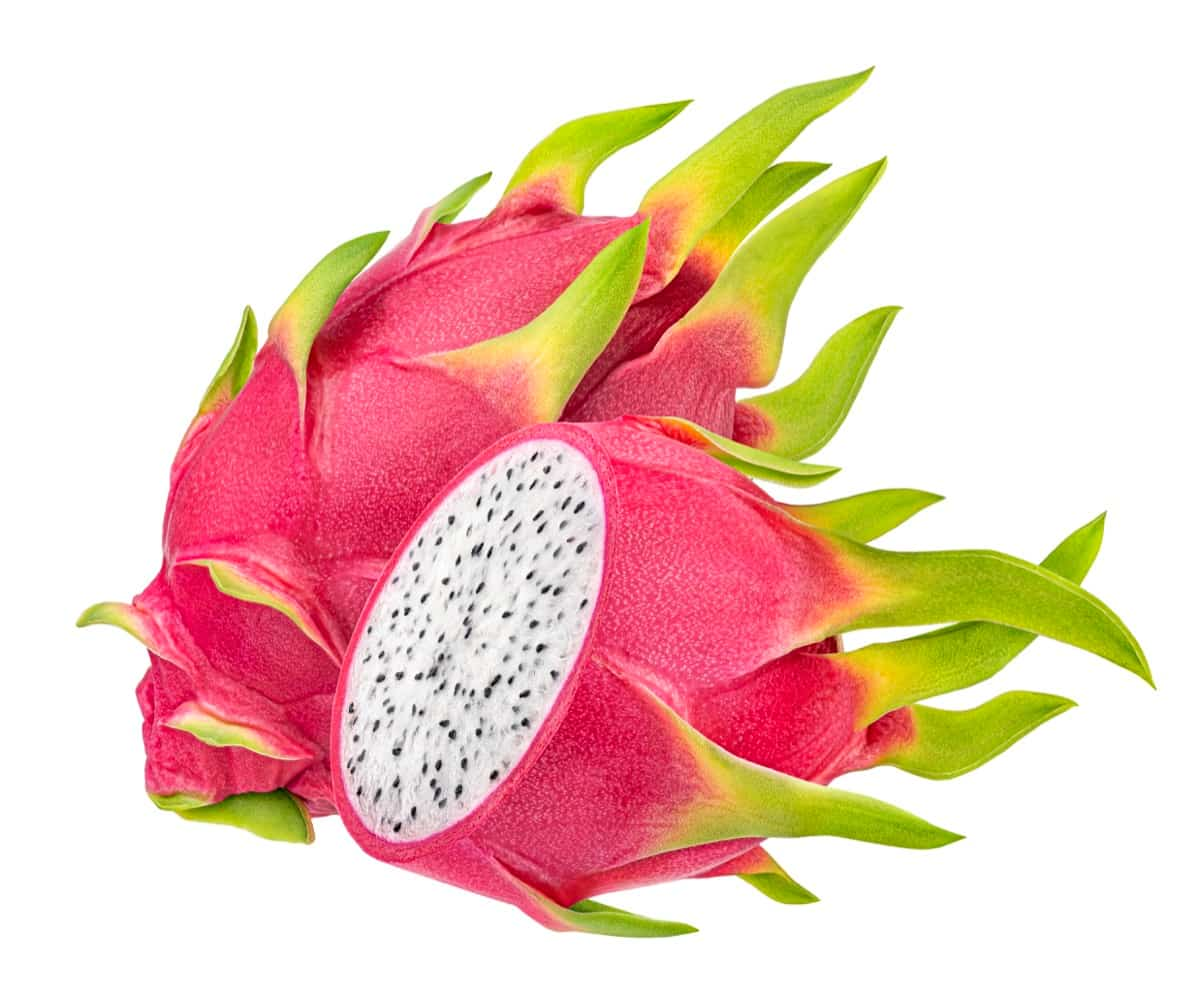Harvesting and post-harvest handling are critical stages in the production of dragon fruit to ensure the fruit’s quality, freshness, and marketability. Dragon fruit harvesting involves careful selection of ripe fruits with vibrant skin color and a slight give when gently squeezed. Here, in this article, we will discuss the harvesting and post-harvest handling of dragon fruit.

Harvesting and Post-Harvest Handling of Dragon Fruits
Best Practices for Harvesting Dragon Fruits: Techniques and Timing
- Timing: Harvest when the fruit’s skin color changes to its typical vibrant hue and it yields slightly to gentle pressure, usually around 30-35 days after flowering.
- Tools: Use clean, sharp shears or a knife to cut the fruit with a small piece of stem attached to prevent damage.
- Avoid Sunlight: Harvest in the early morning or late afternoon to avoid the sun’s heat, which can cause sunburn and reduce fruit quality.
- Handle with Care: Minimize bruising by handling the fruit gently.
- Sort and Store: Sort fruits by size and ripeness, and store them in a well-ventilated area at room temperature or a cool, dry place for extended storage. Avoid stacking to prevent compression.
Factors Affecting the Quality during Harvesting and Post-Harvest Handling of Dragon Fruits
- Harvest Timing: Picking fruits at the right stage of ripeness is crucial for optimal quality.
- Handling Care: Gentle handling prevents bruising and skin damage, which can reduce the fruit’s shelf appeal.
- Environmental Conditions: Exposure to excessive heat, sunlight, or humidity can lead to sunburn, spoilage, or overripening.
- Sanitation: Clean tools, containers, and storage areas to prevent contamination and decay.
- Temperature and Humidity: Maintaining the proper storage conditions, typically around 10-15°C with low humidity, helps extend shelf life.
- Sorting: Categorizing fruits by size and ripeness ensures consistent quality.
- Packaging: Proper packaging materials and techniques are vital to prevent physical damage during transportation and storage.
Pre-Harvest Considerations for Dragon Fruit Cultivation: Optimal Growing Conditions
Dragon fruit cultivation requires careful pre-harvest considerations to optimize growth. The optimal growing conditions include well-draining soil with a slightly acidic pH (5.5-7), full sun exposure, and protection from strong winds. Proper spacing between plants (6-8 feet apart) allows for good air circulation. Regular irrigation is essential, especially during the dry season, but excessive moisture should be avoided.
In case you missed it: Comparative Analysis of Different Growing Systems for Dragon Fruits

Fertilization with a balanced NPK fertilizer and organic matter improves fruit production. Pest and disease management should be proactive, and pollination assistance may be necessary. Pruning, trellising, and adequate support for the climbing cacti are also important for optimal fruit development.
Harvesting Techniques for Dragon Fruits: Picking, Sorting, and Packaging
Harvesting dragon fruits involves a systematic approach. Fruits should be picked when they reach their optimal ripeness, typically 30-35 days after flowering, by twisting them gently from the stem. Harvesting should be done in the early morning or late evening to avoid high temperatures. Sorted fruit should be free from blemishes and damage. The shelf life of dragon fruit is 4-6 weeks.
Packaging is vital for preserving quality; individual wrapping in soft padding or placing in vented plastic containers can prevent bruising. Labels indicating the date of harvest and variety are important. Cold storage at 10-12°C can extend shelf life. Efficient handling and prompt transport to market are crucial for freshness and quality.
Post-Harvest Handling of Dragon Fruits: Cleaning, Sanitizing, and Storage
Post-harvest handling of dragon fruits is critical to maintaining quality. Fruits should be gently cleaned with water to remove dirt and debris. Sanitizing with a mild bleach solution (1-2%) helps eliminate pathogens. Air-drying or using clean, disposable towels is crucial before packing. Properly ventilated storage is essential; fruits should be kept at 10-12°C with 90-95% relative humidity to extend shelf life. Monitoring of temperature and humidity levels regularly is vital to prevent spoilage. Periodic inspections for signs of ripening or decay are crucial to ensure only high-quality fruits reach the market.
Quality Assessment of Dragon Fruits during Post-Harvest Handling: Evaluating Maturity and Ripeness
Assessing the quality of dragon fruits during post-harvest handling is crucial. To evaluate maturity, consider skin color – a ripe fruit should have bright, uniform coloring with no green patches. Gentle squeezing should yield slight flexibility without being too soft. The presence of dried flower remnants at the fruit’s base indicates maturity. To assess ripeness, look for a slight give when gently squeezed; an overly soft fruit is overripe. Fragrance is a key indicator; ripe dragon fruits emit a sweet, floral scent. Additionally, check for evenly colored skin and vibrant flesh.
Packaging and Transportation Strategies for Preserving Dragon Fruit Quality
- Use cushioned containers like foam or cardboard boxes with ventilation to prevent bruising and allow for air circulation.
- Wrap each fruit in soft padding or place them in separate compartments to prevent damage during transit.
- Maintain a consistent storage temperature of 10-12°C to prevent overripening. Use refrigerated trucks if possible.
- Maintain high humidity levels (90-95%) to reduce moisture loss and prevent dehydration of the fruits.
- Keep dragon fruits separate from ethylene-producing fruits to prevent premature ripening.
In case you missed it: Companion Planting with Dragon Fruits: Beneficial Plant Species

Post-Harvest Diseases and Disorders in Dragon Fruits: Identification and Management
- Anthracnose: Identify dark, sunken lesions on the skin. Manage with fungicidal treatments and proper sanitation.
- Gray Mold: Observe brown, fuzzy mold growth. Control through ventilation, moisture reduction, and post-harvest fungicides.
- Bacterial Soft Rot: Recognize watery, foul-smelling fruit with brown or black decay. Improve sanitation and avoid injuries during handling.
- Chilling Injury: Identify brown, watery pulp from exposure to low temperatures. Prevent by maintaining recommended storage temperatures.
- Dehydration: Observe shriveled skin and flesh. Maintain high humidity levels during storage.
Value-Added Processing of Dragon Fruits: Maximizing Shelf Life and Marketability
- Dried Dragon Fruit: Dehydrated dragon fruit slices or cubes extend shelf life and create a convenient snack or ingredient for various products.
- Dragon Fruit Puree: Purees are versatile for making juices, smoothies, desserts, and sauces, with an extended shelf life through proper pasteurization.
- Dragon Fruit Jams and Jellies: Creating spreads adds value and convenience, with a longer shelf life compared to fresh fruit.
- Dragon Fruit Sorbets and Ice Creams: These frozen treats cater to a broader market and offer a unique flavor.
Best Marketing Strategies for Dragon Fruits
- Utilize social media, a website, and online marketplaces to reach a global audience.
- Provide information about the fruit’s health benefits, culinary uses, and unique characteristics to engage and educate consumers.
- Collaborate with supermarkets, health food stores, and restaurants to increase visibility and accessibility.
- Offer introductory offers, bundle deals, or seasonal discounts to attract new customers.
- Invest in visually appealing packaging and brand identity to stand out on shelves and online platforms.
Frequently Asked Questions on Harvesting and Post-Harvest Handling of Dragon Fruits
What Is The Method Of Harvesting Dragon Fruit?
To harvest dragon fruit, use clean pruning shears to cut the fruit from the plant when it reaches the right maturity stage (pink or yellow skin, slightly soft but not mushy). Handle the fruit gently to avoid damage.
What Are The Post Harvest Losses Of Dragon Fruit?
Post-harvest losses of dragon fruit can occur due to factors like physical damage, chilling injury, spoilage, and improper storage conditions. The key causes include bruising, fungal infections, and dehydration.
When And How To Harvest Dragonfruit?
Harvest dragon fruit when its skin color changes from green to pink or yellow and it feels slightly soft but not mushy. Use clean pruning shears to cut the fruit from the plant, leaving a small portion of the stem attached. Handle the fruit gently to prevent damage.
In case you missed it: Managing Weeds in Dragon Fruit Farms: Strategies and Techniques

How Many Times Do You Harvest Dragon Fruit?
Dragon fruit is typically harvested two to three times per year, depending on the climate and growing conditions in the region.
How Many Months Will Dragon Fruit Grow?
Dragon fruit plants typically take around 6 to 9 months to grow from a flowering stage to produce ripe fruits.
Conclusion
In conclusion, successful marketing strategies often require a mix of offline and online approaches. By following proper harvesting and post-harvest handling of dragon fruits practices and adopting effective marketing strategies, you can position your dragon fruit business for success in a competitive market.
- Feed Your Flock for Less: Top 10 Tips to Save on Chicken Feed
- Ultimate Guide to Ossabaw Island Hog: Breeding, Raising, Diet, and Care
- Hatching Answers: The Top 10 Reasons Your Chickens Aren’t Laying Eggs
- Eggs and Economics: Breaking Down the Cost of Raising Backyard Chickens
- Defend Your Greens: Proven Methods to Keep Iguanas Out of Your Garden
- Ultimate Guide to Cinnamon Queen Chicken: A Comprehensive Guide for Beginners
- Ultimate Guide to California Tan Chicken: Breeding, Raising, Diet, Egg-Production and Care
- Ultimate Guide to Marsh Daisy Chicken: Breeding, Raising, Diet, and Care
- 10 Types of Chicken Farming Businesses You Can Start for Profits